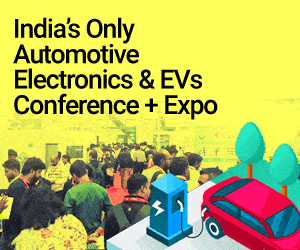India has always potentially wanted smart retailing considering the rapid fluctuation in prices that commodities within the economy undergo as well as for a balanced customer experience. Supermarket chains that have sprang up all throughout the country have always promised a uniform and consistent shopping experience, but still lag behind when it comes to offering fresh products. Age-old methods are still employed to check inventory and refill these.
Also, with customers not in the know-how of inventory-related aspects (within the retail stores), smart retailing and smart stores could potentially be a way out here as far as offering complete transparency to customers is concerned. With the Internet of Things (IoT) making rapid penetrations within the Indian scheme of things, engineers could keep the retail sector on top of their minds while developing IoT-driven smart solutions.
Engineering IoT-driven solutions will thwart plaguing challenges in retail
A foremost aspect that embedded system engineers should keep in mind is the fact that sheer management of categories and the existing products is a major challenge to retailers. These issues are compounded when customer focus comes into the picture.
However, IoT experts feel that smart technology has enough potential to thwart the plaguing challenges.
“With the introduction of IOT solutions such as thermal imaging sensors, wi-fi based solutions and more, retailers can have a better understanding of customer journey inside the store,” states Shankar Narayan R who is Business Analyst and Functional Consultant at Happiest Minds Technologies.
Shankar is also optimistic about this approach yielding results as far as connecting customers to the products on offer at the retail store is concerned, in addition to retailers tracking customer behaviour effectively.
“Retailers can also analyse customer interest levels and pin-point locations for promotional activities and customized deals,” adds Shankar.
“Engineers can develop customised beacons that act as sensors to assist retailers in even creating, then offering, customised solutions based on individual needs. This, in turn, leads to an enhancement of the customer-vendor relationship,” states Avinash Kaushik – founder and chief executive officer at Bengaluru-based Revxx Hardware Accelerator.
With customer engagement and connection (with the retail stores) taken care of, another plaguing issue (as detected by IoT experts) is inventory management.
Shankar believes that enhancement of overall operational efficiency is the need of the hour for retailers. In this regard, engineers can create dynamic solutions to manage retail inventory in real time along with tracking ad-hoc price change and taking care of assets.
“For instance, with electronic shelf label solutions and digital labels, dynamic price changes can happen within few seconds, thereby reducing dependency on labour and effecting an improvement in the updating time,” adds Shankar.
“It will also help retailers to establish price synchronization between point of sale (POS) and other sale channels.”
In the physical world, what should a smart store comprise of?
IoT solution providers and engineers should aim to create stores that harness energy optimally through a custom-designed energy usage system. Also, there would be smart shelves to directly track and monitor inventory along with generating inventory-related reports in real-time. These elements can be used in tandem with customer behaviour analysis patterns to detect buying preference.
“Smart solutions will have higher degree of lead conversions (into actual sales) with the right systems in place. Big Data and Analytics will also play a vital role in estimating the lead conversion rate and possibility,” adds Bengaluru-based independent consultant Pradeep Kumar G. Pradeep also offers training on embedded systems to budding engineers desirous of developing technology-driven solutions.
Another solution that Avinash proposes is a sensor-ridden smart system that can track the way customers react while looking at products. This can be accomplished by capturing facial expressions and via eyeball tracking of buyers. Data (enormous amounts) generated here can be analysed through Analytics, and complex artificial algorithms can be used to point out the most effective options for sales staff (in-store) to ensure actual purchases.
“IoT is the key driver. Smart sensors can be implemented at every level in the store to capture customers’ preferences,” advises Avinash.
“Early adopters will be positioned to more quickly deliver IoT-enabled capabilities that can increase revenue, reduce costs and drive a differentiated brand experience,” states Bastin Robins J – who is chief data scientist at Bengaluru-based Hash Research Labs.
IoT-driven smart technology would be a perfect fit in today’s multi-brand retail
With multi-brand retail stores having gained footing in the western economies, and staring at making an impact in India, embedded system experts believe that buyers would still get to derive profit whilst not being spoilt for choices. As it is widely known that customers opting to shop at supermarkets and multi-brand retail stores would buy multiple products, smart retailing will recommend the right choices at no additional premium costs.
“Engineers can create simple analytical models to enable retailers to understand co-relation between products that are purchased together.,” states Shankar.
An illustration of this scenario would be to run analytics on customers having purchased pasta and also on buyers who have bought wine. Data here can be integrated to find out matches to then recommend a wine to pasta customers and vice-versa. However, it is worth remembering that big data should not be over-used to bombard buyers with products, rather a straight-forward technology-driven minimalistic approach should do the trick.
This would be a profit situation for retailers as they get actionable insights through analytics, and thereby reserve their best efforts to procure highest-quality products.
“Retailers would also be in a position to charge brands a premium amount for smart solutions implemented. So even retailers stand to gain monetarily from smart retail stores,” believes Avinash.
Implementation of smart retail technology at ground level – earlier the better
With the penetration of smart retail in India still at its infancy, IoT solution providers believe that this is the right time for engineers to start-off with pilot models. Again, analytics can be run on data provided by the retailers (non-smart ones) to find out feasibility of smart technology.
“Sensors are easy to procure, programming these should also not be a matter of concern. However, the main challenge at this stage is defining the scalability. Analytics should be used in these scenarios with caution considering the amount of data involved,” adds Harish Babu – chief trainer at Keonics Karnataka.
Other aspects with respect to mass implementation include integration of requirements within new as well as existing data systems so that available data is utilised optimally. This can be used in tandem with the models involved in developing (and designing) the technical architecture.
The next step is to build rich user experience, and then defining the business key performance indicators (KPI) to be monitored.
Ground reality of smart retail technology in India
“ Honestly speaking IoT product companies are struggling to get the market foothold in India,” believes Avinash. This means that there is still a lot of scope for research in the market.
Other generalised set of challenges for IoT engineers include the energy consumption. Demand vs supply with respect to power is still unbalanced in India. “Therefore, embedded engineers should develop low-power consuming models,” advises Shankar.
Also, with existing data security and privacy risks, IoT solution providers should always look at incorporating security right from the level of sensor programming.
Yet another ground level challenge identified by experts is the return on investment on initiatives such as the electronic shelf label.
Apart from these, experts also view educating buyers as another issue considering the fact that e-commerce has found a permanent place in the lives of Indian shoppers. However, certain providers have an IoT-way out here.
Airflash – a potential shot in the arm for brick-and-mortar retail
Avinash Kaushik is working on brick-and-mortar retail stores called Airflash that are due to launch shortly.
“Airflash retail stores would showcase IoT-exclusive devices and gadgets. Here, people can simply walk-in and experience these products unboxed,” states Avinash.
“These Physical stores will be e-commerce enablers and will help Amazon, Flipkart and others to improve their urban penetrations in the new age categories of IoT.”
This statement is an indicator of the fact that both mediums of retailing will benefit, rather than create intensive competition amongst the existing players; both online and physical retail stores.
“We are currently signing up brands both from large corporates and startups to showcase their products in our physical stores to reach wider customer base beyond traditional retail channels,” adds Avinash.
Smart Retailing in creating jobs
Another important aspect at this stage is IoT experts’ belief in integrating, smart retail aspects, to appropriate engineering branches so that employability of graduating engineers is potentially enhanced.
“Retail has been a major job creator for India and we are one of the largest consumer base in the world,” signs-off Avinash.
“Smart retailing concepts should be introduced as a hardcore study subject by technical universities across the country. This will drive both engineering as well as business prospects,” believes Harish Babu.
Finally, with experts and technologists optimistic about driving smart retail stores in India, embedded engineers out there can put their technical hats on and start thinking.
Experts Consulted
| Shankar Narayan R | Business Analyst and Functional Consultant at Happiest Minds Technologies |
| Avinash Kaushik | Founder and CEO at Bengaluru-based Revxx Hardware Accelerator |
| Pradeep Kumar G | Bengaluru-based independent technology consultant and IoT trainer |
| Harish Babu | Chief Technology Trainer at Keonics Karnataka, and Technology Consultant |
| Bastin Robins J | Chief Data Scientist at Bengaluru-based Hash Research Labs |
Written by Rahul R, Senior Technical Journalist at EFY








